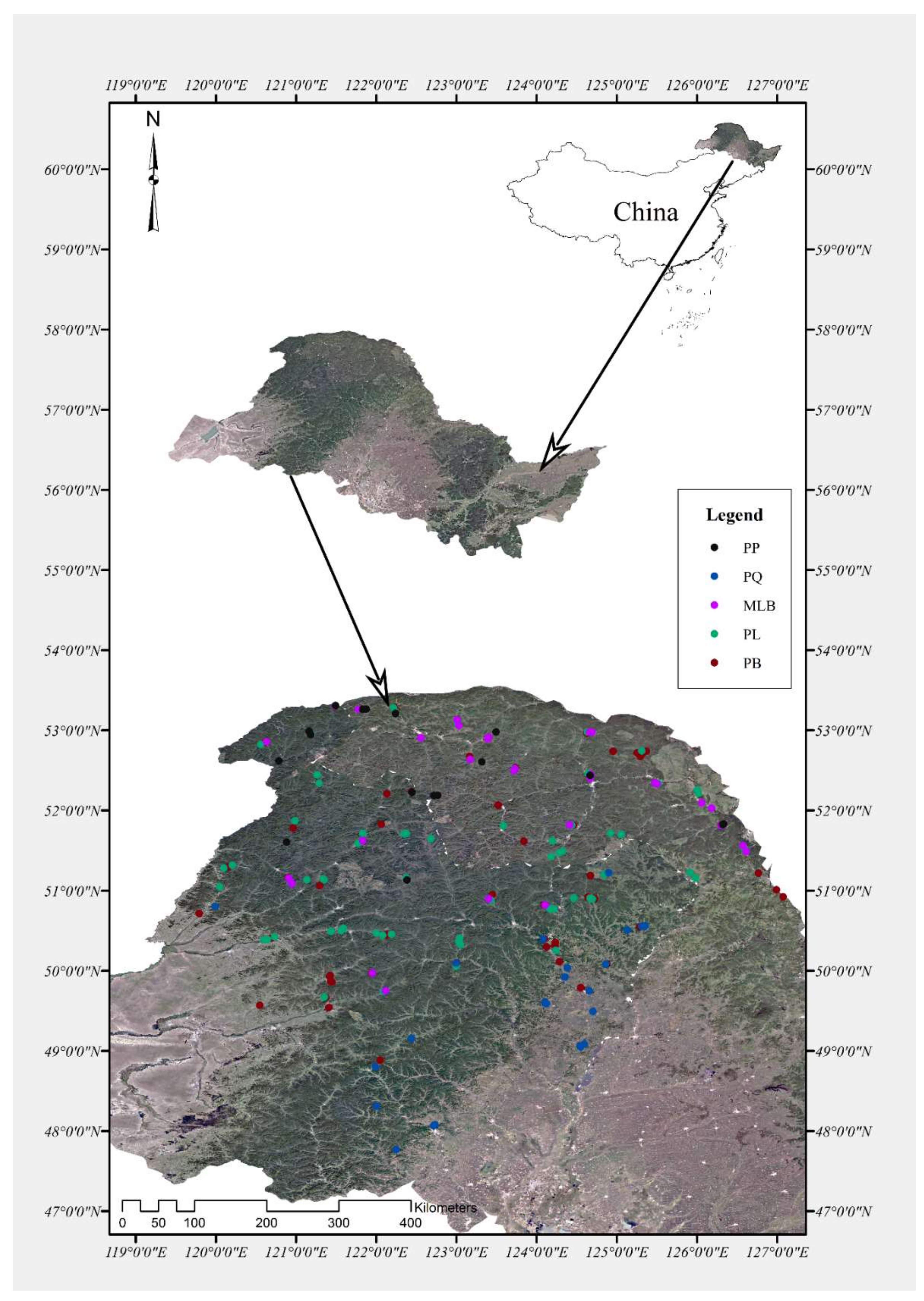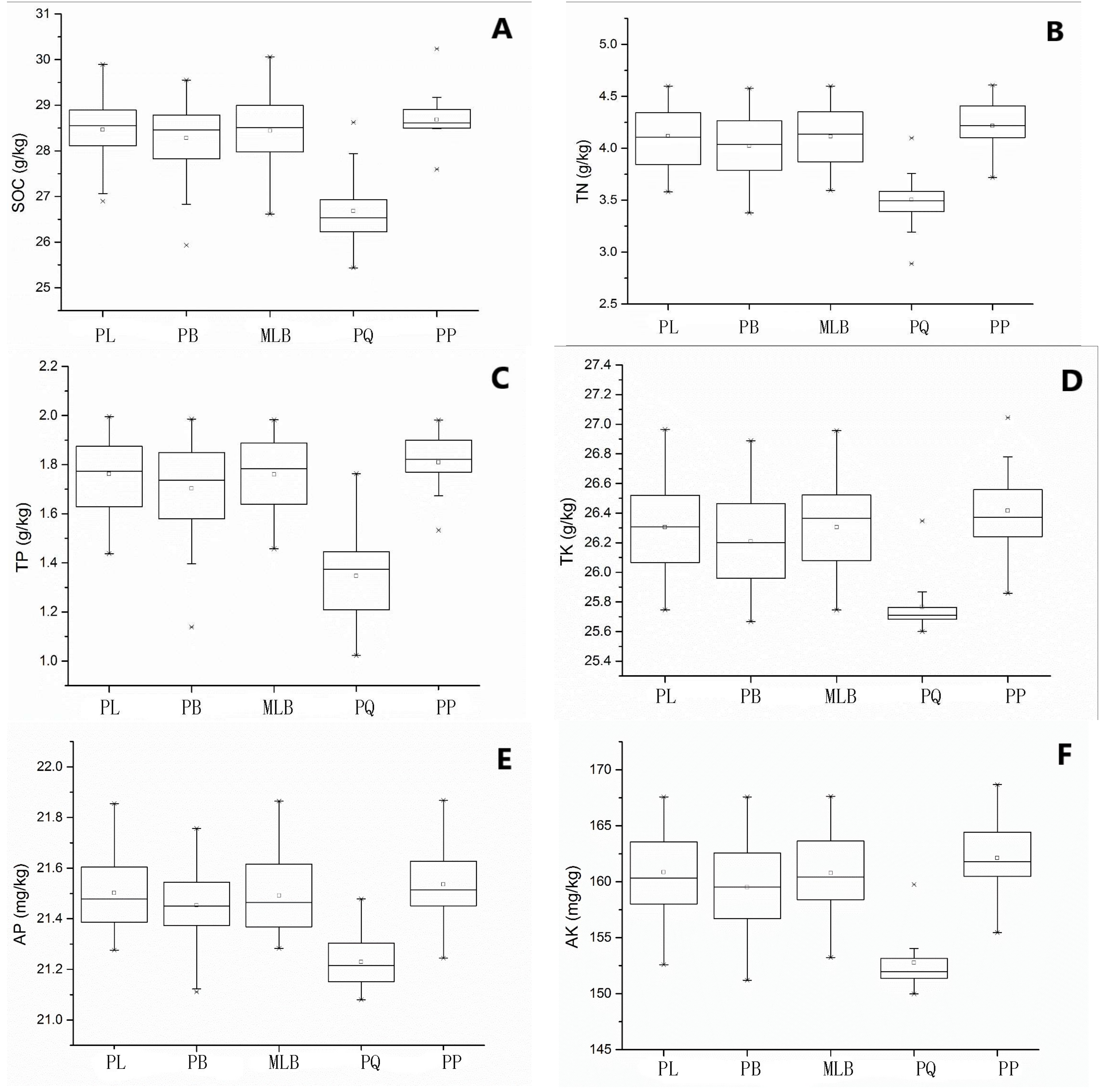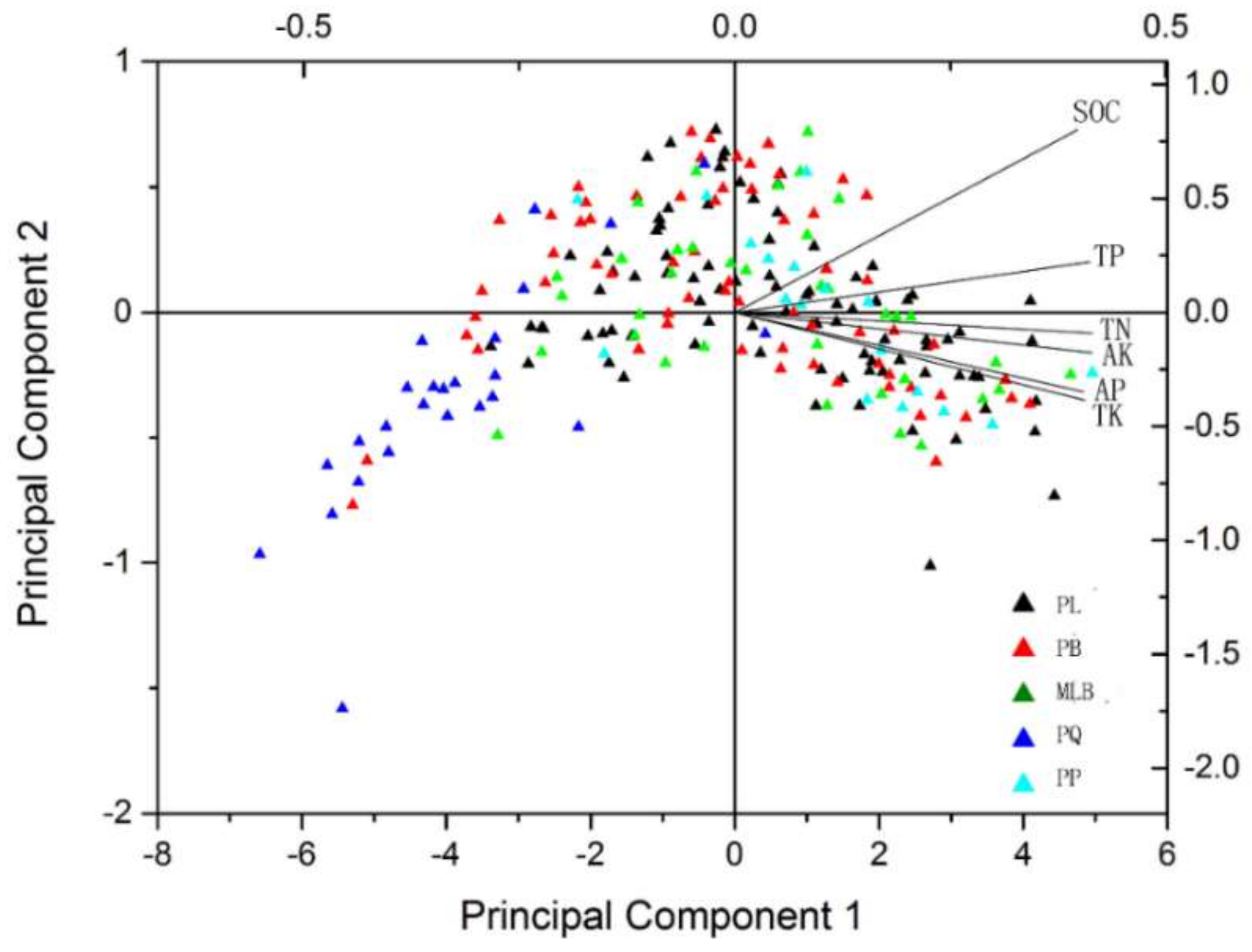Regional Scale Determinants of Nutrient Content of Soil in a Cold-Temperate Forest
Abstract
:1. Introduction
2. Methods
2.1. Site Description
2.2. Field Soil Sampling and Preliminary Analysis
2.3. Climatic Data
2.4. Statistical Analyses
3. Results
3.1. Variation of Soil Nutrients and Climatic Factors in Different Forest Types
3.2. Principal Component Analysis of the Different Forest Types and the Soil Nutrients
3.3. Correlations between Climatic Factors and Soil Nutrients
3.4. Stepwise Regressions between Climatic Factors and Soil Nutrients
4. Discussion
4.1. Forest Types Influence Soil Nutrient Contents
4.2. Soil Nutrient Responses to Climatic Factors
5. Conclusions
Acknowledgements
Author Contributions
Conflicts of Interest
References
- Schimel, D.S.; Braswell, B.H.; Holland, E.A.; Mckeown, R.; Ojima, D.S.; Painter, T.H.; Parton, W.J.; Townsend, A.R. Climatic, edaphic, and biotic controls over storage and turnover of carbon in soils. Glob. Biogeochem. Cycles 1994, 8, 279–294. [Google Scholar] [CrossRef]
- Brittany, G.J.; Paul, J.V.; John, A.A. Effects of climate and vegetation on soil nutrients and chemistry in Great Basin studied along a latitudinal-elevational climate gradient. Plant Soil 2014, 382, 151–163. [Google Scholar]
- Duan, X.W.; Rong, L.; Hu, J.M.; Zhang, G.L. Soil organic carbon stocks in the Yunnan Plateau, southwest China: Spatial variations and environmental controls. J. Soil Sediments 2014, 14, 1643–1658. [Google Scholar] [CrossRef]
- Campos, C.A.; Auilar, G.S.; Landgrave, R. Soil organic carbon stocks in Veracruz State (Mexico) estimated using the 1:250,000 soil database of INEGI: Biophysical contributions. J. Soil Sediments 2014, 14, 860–871. [Google Scholar] [CrossRef]
- Hobley, E.; Wilson, B.; Wilkie, A.; Gray, J.; Koen, T. Drivers of soil organic carbon storage and vertical distribution in Eastern Australia. Plant Soil 2015, 390, 111–127. [Google Scholar] [CrossRef]
- Solomon, D.; Fritzsche, F.; Lehmann, J.; Tekalign, M.; Zech, W. Soil organic matter dynamics in the subhumid agroecosystems of the Ethiopian Highlands. J. Organomet. Chem. 2002, 66, 35–42. [Google Scholar]
- Chandra, L.R.; Gupta, S.; Pande, V.; Singh, N. Impact of forest vegetation on soil characteristics: A correlation between soil biological and physico-chemical properties. 3 Biotech. 2016, 6, 188. [Google Scholar] [CrossRef] [PubMed]
- Prietzel, J.; Christophel, D.; Traub, C.; Kolb, E.; Schubert, A. Regional and site-related patterns of soil nitrogen, phosphorus, and potassium stocks and Norway spruce nutrition in mountain forests of the Bavarian Alps. Plant Soil 2015, 386, 151–169. [Google Scholar] [CrossRef]
- Jiang, F.; Wu, X.; Xiang, W.H.; Fang, X.; Zeng, Y.L.; Ouyang, S.; Lei, P.F.; Deng, X.W.; Peng, C.H. Spatial variations in soil organic carbon, nitrogen and phosphorus concentrations related to stand characteristics in subtropical areas. Plant Soil 2017, 413, 289–301. [Google Scholar] [CrossRef]
- Gosz, J.R. Nitrogen cycling in coniferous ecosystems. Ecol. Bull. (Sweden) 1981, 33, 405–426. [Google Scholar]
- Augusto, L.; Ranger, J.; Dan, B.; Rothe, A. Impact of several common tree species of European temperate forests on soil fertility. Ann. For. Sci. 2002, 59, 233–253. [Google Scholar] [CrossRef]
- Wu, J.; Liu, Q. Charcoal-recorded climate changes from Moon Lake in Late Glacial. J. China Univ. Geosci. 2012, 37, 947–954. [Google Scholar]
- Wang, X.Y.; Zhao, C.; Yu, J. Impacts of Climate Change on Forest Ecosystems in Northeast China. Adv. Clim. Chang. Res. 2013, 4, 230–241. [Google Scholar]
- Jiang, C.Q.; Xu, Q.; Jiang, P.K. Integrated evaluation of soil chemical and biochemical fertility under different vegetations. For. Res. 2002, 15, 700–705. [Google Scholar]
- Qu, K.Y.; Dai, L.M.; Feng, H.M.; Zhang, H.S. Soil fertility characteristics of main forest types in Easten Mountain areas of Liaoning. Chin. J. Soil Sci. 2009, 40, 558–562. [Google Scholar]
- Zu, Y.G.; Li, R.; Wang, W.J.; Su, D.X.; Wang, Y.; Qiu, L. Soil organic and inorganic carbon contents in relation to soil physicochemical properties in northeastern China. Acta Ecol. Sin. 2011, 31, 5207–5216. [Google Scholar]
- Zhou, Y.L. Geography of the Vegetation in Northeast China; Science Press: Beijing, China, 1997. [Google Scholar]
- Yu, J.H.; Wang, C.J.; Wan, J.Z.; Han, S.J.; Wang, Q.G.; Nie, S.M. A model-based method to evaluate the ability of nature reserves to protect endangered tree species in the context of climate change. For. Ecol. Manag. 2014, 327, 48–54. [Google Scholar] [CrossRef]
- Wan, J.; Wang, C.; Han, S.; Yu, J. Planning the priority protected areas of endangered orchid species in northeastern China. Biodivers. Conserv. 2014, 23, 1395–1409. [Google Scholar] [CrossRef]
- Avery, B.W.; Bascomb, C.L. Soil Survey Laboratory Methods; Rothamsted Experimental Station, Lawes Agricultural Trust: Harperden, UK, 1974. [Google Scholar]
- Bao, S.D. Soil and Agricultural Chemistry Analysis; China Agriculture Press: Beijing, China, 2000. [Google Scholar]
- Kumar, P. Assessment of impact of climate change on Rhododendrons in Sikkim Himalayas using Maxent modelling: Limitations and challenges. Biodivers. Conserv. 2012, 21, 1251–1266. [Google Scholar] [CrossRef]
- Pachauri, R.K.; Reisinger, A. Climate Change 2007: Synthesis Report; Contribution of Working Groups I, II and III to the Fourth Assessment Report of the Intergovernmental Panel on Climate Change; IPCC: Paris, France, 2007; p. 104. [Google Scholar]
- Blecker, S.W.; Stillings, L.L.; Amacher, M.C.; Ippolito, J.A.; Decrappeo, N.M. Development of vegetation based soil quality indices for mineralized terrane in arid and semi-arid regions. Ecol. Indic. 2012, 20, 65–74. [Google Scholar] [CrossRef]
- Bautista-Cruz, A.; León-González, F.D.; Carrillo-González, R.; Robles, C. Identification of soil quality indicators for maguey mezcalero (Agave angustifolia Haw.) plantations in Southern Mexico. Afr. J. Agric. Res. 2011, 6, 4795–4799. [Google Scholar]
- Ouyang, W.; Huang, H.; Hao, F.; Shan, Y.; Guo, B. Evaluating spatial interaction of soil property with non-point source pollution at watershed scale: The phosphorus indicator in Northeast China. Sci. Total Environ. 2012, 432, 412–421. [Google Scholar] [CrossRef] [PubMed]
- Sharma, K.L.; Grace, J.K.; Mishra, P.K.; Venkateswarlu, B.; Nagdeve, M.B.; Gabhane, V.V.; Sankar, G.M.; Korwar, G.R.; Chary, G.R.; Rao, C.S. Effect of soil and nutrient-management treatments on soil quality indices under cotton-based production system in Rainfed Semi-arid Tropical Vertisol. Commun. Soil Sci. Plant 2011, 42, 1298–1315. [Google Scholar] [CrossRef]
- Batey, T. Soil compaction and soil management—A review. Soil Use Manag. 2010, 25, 335–345. [Google Scholar] [CrossRef]
- Jagadamma, S.; Lal, R.; Hoeft, R.G.; Nafziger, E.D.; Adee, E.A. Nitrogen fertilization and cropping system impacts on soil properties and their relationship to crop yield in the central Corn Belt, USA. Soil Tillage Res. 2008, 98, 120–129. [Google Scholar] [CrossRef]
- Chang, J.; Clay, D.E.; Dalsted, K.; Clay, S.; O’neill, M. Corn (L.) yield prediction using multispectral and multidate reflectance. Agron. J. 2003, 95, 1447–1453. [Google Scholar] [CrossRef]
- Hothorn, T.; Everitt, B.S. A Handbook of Statistical Analyses Using R, 3rd ed.; CRC Press: Boca Raton, FL, USA, 2014; Volume 37, p. 434. [Google Scholar]
- Andrews, S.S.; Carroll, C.R. Designing a soil quality assessment tool for sustainable agroecosystem management. Ecol. Appl. 2011, 11, 1573–1585. [Google Scholar] [CrossRef]
- Wang, F.; Huang, M.; Sun, X.H.; Gong, Y.Z.; Wang, J.B. Evaluation of soil nutrients for different forest types in Xing′an Mountains forest area. Bull. Soil Water Conserv. 2013, 33, 182–187. [Google Scholar]
- Christensen, J.H.; Carter, T.R.; Rummukainen, M.; Amanatidis, G. Evaluating the performance and utility of regional climate models: The PRUDENCE project. Clim. Chang. 2007, 81, 1–6. [Google Scholar] [CrossRef]
- Gavazov, K.S. Dynamics of alpine plant litter decomposition in a changing climate. Plant Soil 2010, 337, 19–32. [Google Scholar] [CrossRef]
- Shanin, V.; Komarov, A.; Khoraskina, Y.; Bykhovets, S.; Linkosalo, T.; Mäkipää, R. Carbon turnover in mixed stands: Modelling possible shifts under climate change. Ecol. Model. 2013, 251, 232–245. [Google Scholar] [CrossRef]
- Deng, L.; Wang, K.B.; Chen, M.L.; Shangguan, Z.P.; Sweeney, S. Soil organic carbon storage capacity positively related to forest succession on the Loess Plateau, China. CATENA 2013, 110, 1–7. [Google Scholar] [CrossRef]
- Harradine, F.; Jenny, H. Influence of parent material and climate on texture and nitrogen and carbon contents of virgin California soils—Texture and nitrogen contents of soils. Soil Sci. 1985, 85, 235–243. [Google Scholar] [CrossRef]
- Yimer, F.; Ledin, S.; Abdelkadir, A. Soil property variations in relation to topographic aspect and vegetation community in the south-eastern highlands of Ethiopia. For. Ecol. Manag. 2006, 232, 90–99. [Google Scholar] [CrossRef]
- Körner, C. Ecological impacts of atmospheric CO2 enrichment on terrestrial ecosystems. Philos. Trans. 2003, 361, 2023–2041. [Google Scholar] [CrossRef] [PubMed]
- Davidson, E.A.; Trumbore, S.E.; Amundson, R. Soil warming and organic carbon content. Nature 2000, 408, 789–790. [Google Scholar] [CrossRef] [PubMed]
- Lenton, T.M.; Huntingford, C. Global terrestrial carbon storage and uncertainties in its temperature sensitivity examined with a simple model. Glob. Chang. Biol. 2003, 9, 1333–1352. [Google Scholar] [CrossRef]
- Orchard, V.A.; Cook, F.J. Relationship between soil respiration and soil moisture. Soil Biol. Biochem. 1983, 15, 447–453. [Google Scholar] [CrossRef]





| Component | Initial Eigenvalues | Extraction Sums of Squared Loadings | Rotation Sums of Squared Loadings | ||||||
|---|---|---|---|---|---|---|---|---|---|
| Total | % of Variance | Cumulative % | Total | % of Variance | Cumulative % | Total | % of Variance | Cumulative % | |
| 1 | 5.733 | 95.551 | 95.551 | 5.733 | 95.551 | 95.551 | 3.363 | 56.058 | 56.058 |
| 2 | 0.133 | 2.217 | 97.768 | 0.133 | 2.217 | 97.768 | 2.503 | 41.710 | 97.768 |
| 3 | 0.068 | 1.134 | 98.903 | ||||||
| 4 | 0.044 | 0.733 | 99.635 | ||||||
| 5 | 0.015 | 0.244 | 99.880 | ||||||
| 6 | 0.007 | 0.120 | 100.000 | ||||||
| Nutrient | MAT | TS | MAP | PS |
|---|---|---|---|---|
| SOC | −0.223 ** | 0.417 ** | 0.311 ** | −0.4700 ** |
| TN | −0.101 | 0.341 ** | 0.411 ** | −0.414 ** |
| TK | −0.052 | 0.312 ** | −0.411 ** | −0.378 ** |
| TP | 0.187 ** | −0.405 ** | −0.383 ** | 0.471 ** |
| AK | −0.106 | 0.365 ** | 0.384 ** | −0.425 ** |
| AP | −0.050 | 0.307 ** | 0.385 ** | −0.367 ** |
| Types Nutrient | MAT | TS | MAP | PS | Types Nutrient | MAT | TS | MAP | PS | ||
|---|---|---|---|---|---|---|---|---|---|---|---|
| PL | SOC | 0.287 ** | 0.130 | 0.543 ** | −0.235 * | PB | SOC | 0.188 | 0.261 * | 0.542 ** | −0.223 |
| TN | 0.380 ** | 0.010 | 0.603 ** | −0.140 | TN | 0.364 ** | 0.176 | 0.600 ** | −0.148 | ||
| TK | 0.376 ** | 0.030 | 0.579 ** | −0.142 | TK | 0.387 ** | 0.191 | 0.586 ** | −0.165 | ||
| TP | 0.349 ** | 0.040 | 0.614 ** | −0.173 | TP | 0.284 * | 0.235 | 0.609 ** | −0.222 | ||
| AK | 0.379 ** | 0.058 | 0.586 ** | −0.172 | AK | 0.345 ** | 0.227 | 0.550 ** | −0.173 | ||
| AP | 0.485 ** | −0.06 | 0.542 ** | −0.061 | AP | 0.365 ** | 0.204 | 0.519 ** | −0.154 | ||
| MLB | SOC | 0.362 * | 0.151 | 0.358 * | −0.274 | PQ | SOC | 0.199 | 0.301 | 0.322 | −0.271 |
| TN | 0.46 ** | 0.151 | 0.455 ** | −0.337 * | TN | 0.295 | 0.202 | 0.426 * | −0.215 | ||
| TK | 0.546 ** | 0.157 | 0.407 * | −0.316 | TK | 0.121 | 0.047 | 0.201 | 0.059 | ||
| TP | 0.549 ** | 0.197 | 0.434 ** | −0.384 * | TP | 0.141 | 0.383 | 0.454 * | −0.332 | ||
| AK | 0.537 ** | 0.188 | 0.418 * | −0.349 * | AK | 0.219 | 0.171 | 0.219 | −0.128 | ||
| AP | 0.556 ** | 0.060 | 0.437 ** | −0.246 | AP | 0.168 | 0.329 | 0.337 | −0.227 | ||
| PP | SOC | 0.309 | 0.126 | 0.360 | −0.470 * | ||||||
| TN | 0.206 | 0.069 | 0.629 ** | −0.453 | |||||||
| TK | 0.270 | 0.044 | 0.614 ** | −0.336 | |||||||
| TP | 0.176 | 0.088 | 0.621 ** | −0.436 | |||||||
| AK | 0.273 | 0.056 | 0.619 ** | −0.485 * | |||||||
| AP | 0.205 | 0.028 | 0.611 ** | −0.464 | |||||||
| Forest Types | Soil Nutrients | R | R2 | Adjusted R2 | Standard Error of the Estimate |
|---|---|---|---|---|---|
| PL | SOC | 0.715 | 0.512 | 0.488 | 0.45880 |
| TN | 0.741 | 0.549 | 0.539 | 0.19099 | |
| TP | 0.734 | 0.538 | 0.527 | 0.10257 | |
| TK | 0.717 | 0.513 | 0.502 | 0.21375 | |
| AP | 0.759 | 0.576 | 0.566 | 0.08648 | |
| AK | 0.726 | 0.527 | 0.516 | 2.61645 | |
| PB | SOC | 0.762 | 0.580 | 0.552 | 0.50973 |
| TN | 0.852 | 0.727 | 0.708 | 0.16591 | |
| TP | 0.829 | 0.687 | 0.665 | 0.10871 | |
| TK | 0.853 | 0.728 | 0.709 | 0.17232 | |
| AP | 0.812 | 0.660 | 0.637 | 0.08950 | |
| AK | 0.844 | 0.713 | 0.694 | 2.29320 | |
| MLB | SOC | 0.606 | 0.367 | 0.307 | 0.60923 |
| TN | 0.803 | 0.644 | 0.611 | 0.17465 | |
| TP | 0.809 | 0.654 | 0.621 | 0.09086 | |
| TK | 0.767 | 0.588 | 0.550 | 0.20503 | |
| AP | 0.740 | 0.548 | 0.520 | 0.09897 | |
| AK | 0.784 | 0.614 | 0.578 | 2.40780 | |
| PQ | SOC | – | – | – | – |
| TN | 0.782 | 0.612 | 0.557 | 0.15610 | |
| TP | 0.454 | 0.206 | 0.172 | 0.16556 | |
| TK | – | – | – | – | |
| AP | – | – | – | – | |
| AK | – | – | – | – | |
| PP | SOC | 0.470 | 0.221 | 0.172 | 0.50111 |
| TN | 0.787 | 0.619 | 0.569 | 0.16243 | |
| TP | 0.759 | 0.576 | 0.520 | 0.08790 | |
| TK | 0.817 | 0.667 | 0.520 | 0.16327 | |
| AP | 0.768 | 0.590 | 0.535 | 0.10037 | |
| AK | 0.822 | 0.676 | 0.633 | 2.13592 |
© 2018 by the authors. Licensee MDPI, Basel, Switzerland. This article is an open access article distributed under the terms and conditions of the Creative Commons Attribution (CC BY) license (http://creativecommons.org/licenses/by/4.0/).
Share and Cite
Yuan, S.; Tang, T.; Wang, M.; Chen, H.; Zhang, A.; Yu, J. Regional Scale Determinants of Nutrient Content of Soil in a Cold-Temperate Forest. Forests 2018, 9, 177. https://doi.org/10.3390/f9040177
Yuan S, Tang T, Wang M, Chen H, Zhang A, Yu J. Regional Scale Determinants of Nutrient Content of Soil in a Cold-Temperate Forest. Forests. 2018; 9(4):177. https://doi.org/10.3390/f9040177
Chicago/Turabian StyleYuan, Shusheng, Tongtong Tang, Minchao Wang, Hao Chen, Aihua Zhang, and Jinghua Yu. 2018. "Regional Scale Determinants of Nutrient Content of Soil in a Cold-Temperate Forest" Forests 9, no. 4: 177. https://doi.org/10.3390/f9040177





